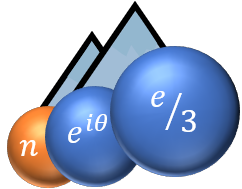A quantum point contact (QPC) is useful for identifying quantumness of particles moving along quantum Hall edge channels. In the integer quantum Hall regime, partitioning of a dilute beam at a QPC results in particle antibunching due to the particle discreteness, while collision of two beams exhibits the electronic Hong-Ou-Mandel effects originating from the fermionic exchange statistics. Recently dilute anyon beams were injected to a QPC in the fractional quantum Hall regime at filling factor 1/3, to identify the quantumness of Abelian anyons [1-5].
We here predict a new effect [6,7] that dominates over the conventional partition or collision in the regime of the experiments. In the effect, an anyon thermally excited at the QPC braids (in time domain) the anyons of the dilute beams arriving at the QPC within the time window of the excitation. This effect of anyonic braiding statistics has no counterpart in bosons and fermions, vanishing in the integer quantum Hall regime. The resulting current noise agrees with the experimental results by a single dilute beam [2] and two dilute beams [1,3,4], identifying braiding of Abelian anyons in both the cases. This effect is generalized with non-Abelian anyons [7], dilute anyon injection to interferometers [8], excitations by voltage pulses [9], mutual anyonic statistics [10,11,12], e.g., of a fractional charge and an electron in the integer quantum Hall regime.
[1] H. Bartolomei et al, Science 368, 173 (2020).
[2] J.-Y. M. Lee et al., arXiv:2209.15461 (2022).
[3] P. Glidic et al., Phys. Rev. X 13, 011030 (2023).
[4] M. Ruelle et al., Phys. Rev. X 13, 011031 (2023).
[5] B. Rosenow, I. P. Levkivskyi, and B. I. Halperin, Phys. Rev. Lett. 116, 156802 (2016).
[6] B. Lee, C. Han, and H.-S. Sim, Phys. Rev. Lett. 123, 016803 (2019).
[7] J.-Y. M. Lee and H.-S. Sim, Nat. Comm. 13, 6660 (2022).
[8] C. Han, J. Park, Y. Gefen, and H.-S. Sim, Nat. Comm. 7, 11131 (2016).
[9] T. Jonckheere, J. Rech, B. Gremaud, and T. Martin, arXiv:2207.07172 (2022).
[10] J.-Y. M. Lee, C. Han, and H.-S. Sim, Phys. Rev. Lett. 125, 196802 (2020).
[11] T. Morel, J.-Y. M. Lee, H.-S. Sim. And C. Mora, Phys. Rev. B 105, 075433 (2022).
[12] N. Schiller, Y. Shapira, A. Stern, and Y. Oreg, arXiv:2301.00021 (2023).

 PDF version
PDF version
